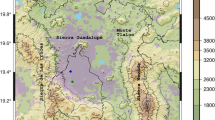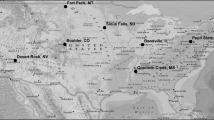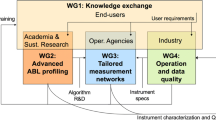Abstract
This study describes an effort to estimate atmospheric mixing height using vertical profiles of thermodynamic variables measured operationally at radiosonde sites in South Korea. We focus on mixing height at 06UTC (15LST) when vigorous daytime convection is expected with clear skies. For this purpose, we developed a simple numerical algorithm using a new data transfer tool, known as cURL, to determine mixing height and applied it to radiosonde data at Osan and Gwangju for 2010. Emphasis was placed on automating as much as possible the process of determining mixing height. According to the preliminary results, the estimation algorithm performed successfully for most cases with clear sky conditions and was useful in diagnosing and monitoring daytime mixing heights more effectively on a near-real-time basis. With the developed algorithm, it is possible to estimate mixing heights from radiosonde data within a few hours of the development of the convective boundary layer. Application to radiosonde sites in other countries is straightforward and continued modifications of the algorithm are anticipated in the near future.








Similar content being viewed by others
References
Byun, D. W., & Ching, J. K. S. (Eds.). (1999). Science algorithms of the EPA Model-3 Community Multiscale Air Quality (CMAQ) modeling system. EPA-600/R-99/030. Washington, D.C: Office of Research and Development, U. S. Environmental Protection Agency.
Choi, J. S., & Baek, S. O. (1998). An approach to estimate daily maximum mixing height (DMMH) in Pohang, Osan, and Kwangju areas — Analysis of 10 years data from 1983 to 1992. Journal of the Korea Air pollution Research Association, 14, 379–385.
Glickman, T. S. (2000). Glossary of meteorology (2nd ed.). Boston: American Meteorological Society.
Hennemuth, B., & Lammert, A. (2006). Determination of the atmospheric boundary layer height from radiosonde and LIDAR backscatter. Boundary-Layer Meteorology, 120, 181–200.
Holzworth, G. C. (1963). Estimates of mean maximum mixing depths in the contiguous United States. Monthly Weather Review, 92, 235–242.
Hong, S. Y., & Pan, H. L. (1996). Nonlocal boundary layer vertical diffusion in a medium-range forecast model. Monthly Weather Review, 124, 2322–2339.
Kim, Y. G. (1998). Calculation of the convective mixed layer by estimation of sensible heat flux. Journal of the Korean Environmental Sciences Society, 7, 639–645.
Lee, J. B. (1991). A study on the air pollution potential in the central part of Korea. Journal of Korea Air pollution Research Association, 7, 41–47.
Lee, S.-J., Parrish, D. F., Park, S.-Y., Wu, W.-S., Greybush, S. J., Lee, W.-J., & Lord, S. J. (2011). Effects of 2-m air temperature assimilation and a new near-surface observation operator on the NCEP Gridpoint Statistical-Interpolation system. Asian-Pacific Journal of Atmospheric Sciences, 47, 353–376.
Lee, S.-J., & Kawai, H. (2011). Mixing depth estimation from operational JMA and KMA wind-profiler data and its preliminary applications: examples from four selected sites. Journal of the Meteorological Society of Japan, 89, 15–28.
Min, K.-D., Kim, S.-H., Kim, K.-E., & Kwon, B.-H. (1999). Seasonal and local characteristics of atmospheric mixed layer over Kyungpook Province. Journal of the Korean Meteorological Society, 35, 539–548.
Park, S.-U., & Yoon, I.-H. (1991). Estimation of atmospheric boundary layer parameters using routinely available meteorological data. Journal of the Korean Meteorological Society, 27, 32–54.
Park, S.-U., Lee, Y.-U., & Bong, J.-H. (1989). Special observations for the growth of the mixed layer. Journal of the Korean Meteorological Society, 25, 138–147.
Sørensen, J. H., & Rasmussen, A. (1997). Mixing height derived from the DMI-HIRLAM NWP model, and used for ETEX dispersion modeling. The determination of the mixing height – current progress and problems, EURASAP Workshop Proceedings, 1–3 October 1997 (pp. 41–44). Roskilde, Denmark: RisØ National Laboratory.
Stull, R. B. (1988). An introduction to boundary layer meteorology (p. 666). Dordrecht: Kluwer Academic.
Yamada, T., & Mellor, G. L. (1975). A simulation of the Wangara atmospheric boundary layer data. Journal of Atmospheric Sciences, 32, 2309–2329.
Yoon, S.-C., Won, J.-G., Kim S.-W., & Lim, G.-M. (1999). Measurement of mixed layer height using Lidar. Proceedings of the Korean Society for Atmospheric Environment, 436–437
Acknowledgements
This study was supported by the Korea Meteorological Administration Research and Development Program under Grant CATER 2013-3030. The first author thanks Dr. Steven Greybush in the Department of Atmospheric and Oceanic Science at University of Maryland, and research scientists in Complex System Science Laboratory at Seoul National University and Forecast Research Division in National Institute for Meteorological Research for their useful comments and cooperation.
Author information
Authors and Affiliations
Corresponding author
Appendix. A sample code using cURL library
Appendix. A sample code using cURL library
The following FORTRAN code gets radiosonde data of 0600UTC (1500LST) 18 May 2012 at Osan (47122) in South Korea from the radiosonde database in the department of atmospheric science, University of Wyoming.

The variable "url" contains a target site address which indicates radiosonde data to be transferred into a local computer. This simple code should be easily applicable to other kinds of meteorological data available in the form of text on a web site.
Rights and permissions
About this article
Cite this article
Lee, SJ., Kim, J. & Cho, CH. An automated monitoring of atmospheric mixing height from routine radiosonde profiles over South Korea using a web-based data transfer method. Environ Monit Assess 186, 3253–3263 (2014). https://doi.org/10.1007/s10661-014-3615-y
Received:
Accepted:
Published:
Issue Date:
DOI: https://doi.org/10.1007/s10661-014-3615-y




